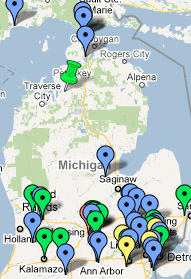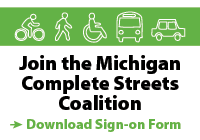You are currently browsing the tag archive for the ‘SEMCOG’ tag.
 SEMCOG, a Michigan Complete Streets Coalition partner, is currently teaming up with MDOT on a regional nonmotorized plan for their seven county region, including Livingston, Macomb, Monroe, Oakland, St. Clair, Washtenaw, and Wayne Counties.
SEMCOG, a Michigan Complete Streets Coalition partner, is currently teaming up with MDOT on a regional nonmotorized plan for their seven county region, including Livingston, Macomb, Monroe, Oakland, St. Clair, Washtenaw, and Wayne Counties.
This planning process includes:
- Collection of all nonmotorized plans for the region (as well as nonmotorized components in Master Plans, Area Plans, Recreation Plans, Complete Streets Plans, etc);
- Digitization of all existing and proposed on-road and off road bicycle facilities into GIS data formats;
- A gap analysis for bike facilities and conceptual plan;
- Public involvement workshops and surveys; and
- A final plan with priority corridors for MDOT facilities and next steps for other road agencies.
To learn more about this regional nonmotorized plan and opportunities to provide public input, please visit SEMCOG’s nonmotorized page.
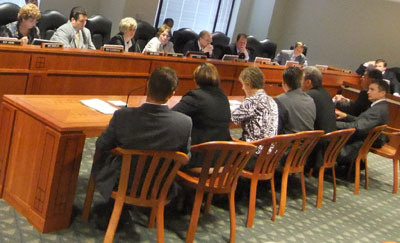
R to L: A panel of supporters including the County Road Association of Michigan, Michigan Environmental Council, Michigan Fitness Foundation, Michigan Municipal League, Michigan Trails and Greenways Alliance, AARP and Representative Jon Switalski testifying in support of HB 6151 and 6152.
The House Transportation Committee voted unanimously to pass HB 6151 and HB 6152 out of committee, with recommendations. This is a big success for Complete Streets, and the Coalition would like to thank all of the stakeholders who worked hard to negotiate a bill that was eventually able to garner such strong support. We would especially like to thank Rep. Wayne Schmidt for his leadership on this issue, as well as Rep. Pam Byrnes, Rep. John Switalski and their staffs, who put a lot of effort to achieve this victory. In hectic fashion, the final drafts of the bills were being revised right up to the last minute, modified to reflect the negotiations made between all parties involved. As Chairwoman Byrnes said, reflecting on the compromises reached, “This bill is not what everybody wants, but it’s a good step forward.”
As the result of negotiations MML, SEMCOG, MDOT and CRAM, many of whom had previously only supported the bills in concept, are now strong supporters of the legislation. The support of these organizations, in addition to the support of most of the GOP members of the committee, bodes well for the future of the bills.
The final revision of the bill no longer requires local road agencies or municipalities to pass their own Complete Streets policies. MDOT, however, is still required to pass a Complete Streets policy, along with a ‘model’ policy for municipalities and counties. As Rep. Switalski said, this version of the bill gives “cities, and locals more say when dealing with transportation policy.” The final bill also gives the Complete Streets Advisory Council a much stronger role in the planning process, allowing them to advise MDOT on the adoption of Complete Streets policies.
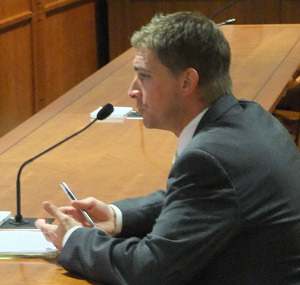
Bill sponsor, Representative Jon Switalski, makes the case for Complete Streets in Michigan before the House Transportation Committee on June 24th, 2010. The Committee went on to vote unanimously in support of the legislation.
Felicia Wasson from AARP used her brief testimony to rightly note that this is “only the beginning - a first step” for Complete Streets. According to the revision, Complete Street policies must consider the “varying mobility needs of all legal users of the roadway, of all ages and abilities.” This language does indeed represent a great first step towards ensuring that everyone is entitled to use roadways safely and conveniently.
The bills will now be referred to the House floor for a second reading, followed by a vote by the full House of Representatives. Rep. Byrnes expects that the bills will be voted on by the House relatively soon. After that, they are on to the Senate committee. It’s important to keep the energy and enthusiasm alive as the bills move forward - look for an updated action alert on our Take Action page in the next few days.
(For a complete look at the process the bills will follow as they become law, download a PDF copy of the Michigan Citizens Guide to State Government)
The Coalition would like to once again thank everyone who has worked with us to see that these bills get passed. Let’s use today’s success as a springboard to redouble our efforts, and push these important bills out of the House and through the Senate!
Additionally, League of American Bicyclists, Alliance for Biking and Walking, and the National Complete Streets Coalition all featured the efforts of Michigan’s Complete Streets movement on their blogs today.
Many more organizations and individuals provided testimony in support of Compete Streets that was entered into the record at the committee meeting as well. The following is list of links to .pdfs of those testimonies.
- Sarah Panken, Active Communities Coordinator for the Michigan Fitness Foundation
- Susan Hargter, Cyclesafe, Inc.
- Robert Prud’homme, LEED for Neighborhood Development, USGBC- Detroit Regional Chapter
- Barbara Kramer, Candidate for Dickinson County Comissioner
- MC Rothhorn, Mid-Michigan Environmental Action Council
- Jim Briggs and Carolyn Grawi, Ann Arbor Center for Independent Living
- Frank Lynn, Concerned Citizens for Improved Transit
- Dave Bulkowski, Disability Advocates of Kent County
- Gary Howe
- Michael Aughenbaugh, Revex, Inc.
- Steven A Roach
- Michael Maisner, Michigan Fitness Foundation
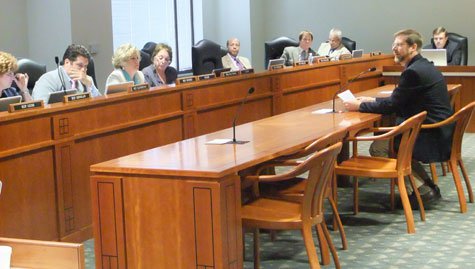
Michigan Complete Streets Coalition member, Norm Cox of the American Society of Landscape Architects used his testimony to state that HB 6152 and 6152 is "working to make amends for the lopsided transportation investments of the last 50-60 years," adding, "it's not taking money away, but redistributing it based on changing priorities."
The second House Transportation Committee hearing on Complete Streets legislation, HB 6151 and 6152, saw the room once again packed with supporters of the policies. The legislation - which seeks to move Michigan away from auto-centric road designs and meet the needs of all roadway users - has attracted strong support from a broad range of advocates. A few of the groups represented at today’s hearing included: The American Heart Association, Crim Fitness Foundation and Citizens for a Safe Community.
The coalition would like to extend thanks to all those who spoke at the meeting today, as well to those that offered written testimony. Chairwoman Byrnes (D - Dist. 52) indicated she plans to hold a vote on the bills next week, and with some organizations like SEMCOG and MML still supporting the bill in concept only, it is important that the committee members continue to hear vocal support for these specific policies.
 Wednesday, March 31, 2010
Wednesday, March 31, 2010
8:30 a.m.-5 p.m.
(Registration begins at 8 a.m.)
Location
SEMCOG Offices
535 Griswold St., Ste. 300
Detroit, MI
Register Now
Objective
This workshop will provide local government engineers and planners responsible for designing public rights-of-way and recreational facilities, and ADA coordinators, with information about federal regulations pertaining to public rights-of-way and outdoor developed areas.
Read the rest of this entry »



